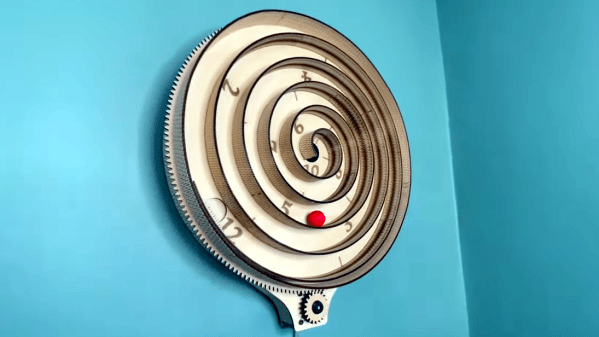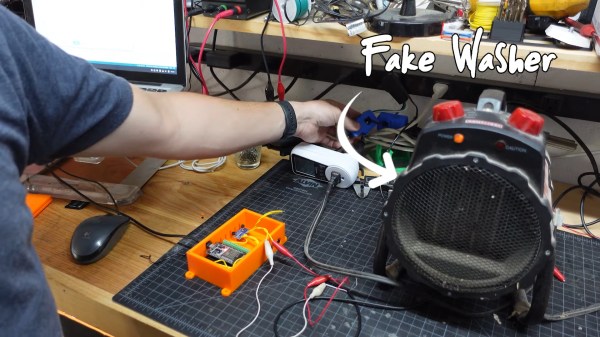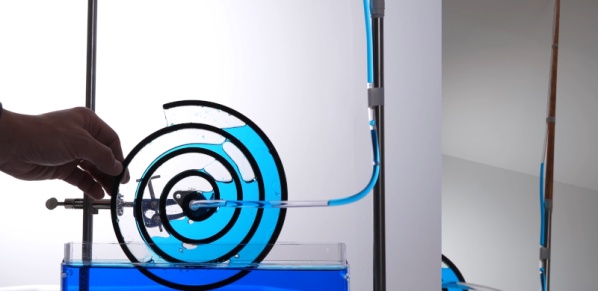Earlier this week, another nation joined the still relatively exclusive club of those which possess a satellite launch capability. North Korea launched their Malligyong-1 spy satellite, and though it has naturally inflamed the complex web of political and military tensions surrounding the Korean peninsula, it still represents something of a technical achievement for the isolated Communist state. The official North Korean news coverage gleefully reported with much Cold War style rhetoric, that Kim Jong-Un had visited the launch control centre the next day and viewed intelligence photographs of an American base in Guam. Could the satellite have delivered in such a short time? [SatTrackCam Leiden] has an interesting analysis. Continue reading “Could North Korea’s New Satellite Have Spied On Guam So Easily?”
The Ghost Detector 9000 Is A Fun Spirit-Chasing Game
Halloween may have come and gone for another year, but we’re still finding neat spooky projects lurking out on the Interwebs. Case in point, the Ghost Detector 9000 from [Jules].
Effectively, what you’re looking at here is a fun interactive ghost-detecting game. It consists of a Raspberry Pi Zero hooked up with an IMU sensor that can detect the rig’s movement and orientation. As the user moves the Ghost Detector 9000 around, it outputs lights and sound when it’s aimed at a so-called “ghost-signal”. The user then pulls the trigger to “capture” the ghost. The whole rig is built inside a flashlight which presented a useful form factor for modification.
For those eager to dive into the nitty-gritty, [Jules] has shared the project files on GitHub. There’s some nifty stuff going on, like Rust code that interfaces with I2C devices hooked up to the Pi, and a sensor-fusion algorithm to make the most out of the data from the 9-axis IMU.
It’s a fun build that probably taught [Jules] a great deal along the way, even if it’s a game at heart. If you prefer to shoot zombies instead of capture ghosts, we’ve seen a build that lets you go hunting with a laser crossbow, too.
Continue reading “The Ghost Detector 9000 Is A Fun Spirit-Chasing Game”
Watch Time Roll By On This Strange, Spiral Clock
[Build Some Stuff] created an unusual spiral clock that’s almost entirely made from laser-cut wood, even the curved and bendy parts.

The clock works by using a stepper motor and gear to rotate the clock’s face, which consists of a large dial with a spiral structure. Upon this spiral ramp rolls a ball, whose position relative to the printed numbers indicates the time. Each number is an hour, so if the ball is halfway between six and seven, it’s 6:30. At the center of the spiral is a hole, which drops the ball back down to the twelve at the beginning of the spiral so the cycle can repeat.
The video (embedded below) demonstrates the design elements and construction of the clock in greater detail, and of particular interest is how the curved wall of the spiral structure consists of a big living hinge, a way to allow mostly rigid materials to flex far beyond what they are used to. Laser cutting is well-suited to creating living hinges, but it’s a technique applicable to 3D printing, as well.
Thanks to [Kelton] for the tip!
Continue reading “Watch Time Roll By On This Strange, Spiral Clock”
3D Printing On A Spinning Rod
FDM 3D printing traditionally operates on a layer-by-layer basis, using a flat bed to construct parts. However, [Humphrey Wittingtonsworth IV] demonstrates in his video how this process can be significantly enhanced in terms of mechanical strength and print speed by experimenting with printing on a rotating rod instead of the standard flat bed.
[Humphrey] modified a Creality CR-10 3D printer by removing the bed and installing a regular 8mm linear rod under the hotend. The rod is rotated by a stepper motor with a 3:1 belt drive. This lets him use the rod as the printing surface, laying down layers axially along the length of an object. This means parts that can stand up to bending forces much better than their upright-printed counterparts.
Additionally, this rotational action allows for printing functional coil and wave springs – even multi-layer ones – something that’s not exactly feasible with your run-of-the-mill printer. It can also create super smooth and precise threads as the print head follows their path. As an added bonus – it could also speed up your printing process as you’re just spinning a slim rod instead of slinging around an entire bed. So cylindrical parts like tubes and discs could be printed almost as quickly as your hotend can melt filament.
Of course, this approach isn’t without its challenges. It works best for cylindrical components and there’s a limit to how small you can go with inner diameters based on your chosen rod size. Then there’s also the task of freeing your prints from their rod once they’re finished. [Humphrey] addressed this by creating mesh sleeves that snugly fit over his center rod. This limits how much melted plastic can adhere to it, making removal a breeze.
Spinning Up A New Laundry Monitor
For all that modern washers and dryers do, they don’t let you know when they’re finished. Or they do, but it’s only a short victory song that plays once and can be easy to miss. What most of us need is a gentle reminder that there’s damp laundry festering in the washer, or fresh laundry in the dryer getting wrinkly.
 This laundry monitor from [Sparks and Code] is version 2.0. The first version was working fine, but it was based on vibration (or lack thereof). Fast forward a few years, and [Sparks and Code] got a modern pair that’s so finely tuned, it doesn’t produce enough vibration to register. Back to the drawing board [Sparks and Code] went, and eventually came up with version 2.0.
This laundry monitor from [Sparks and Code] is version 2.0. The first version was working fine, but it was based on vibration (or lack thereof). Fast forward a few years, and [Sparks and Code] got a modern pair that’s so finely tuned, it doesn’t produce enough vibration to register. Back to the drawing board [Sparks and Code] went, and eventually came up with version 2.0.
Now, [Sparks and Code] is detecting whether the machines are on using a pair of split-core transformers to monitor power at the breaker box. With these, you just run the wire through the hole, and it gives the relative mV value going through the wire on a 3.5mm cable. Those cables are connected to an ESP32 inside the 3D-printed box, which is mounted above the cabinet door. Since [Sparks and Code] already has home assistants all over the house, it was easy to integrate and have them all play the message ‘please flip the laundry’.
Once this project was all buttoned up, they thought of one issue — the self-cleaning cycle. Since it takes about four hours, they like to run it overnight. You can see the problem here — no one wants to hear Alexa at 3AM. Fortunately, [Sparks and Code] was able to adjust the Python script to ignore these events. Be sure to check out the build video after the break.
If only the dryer could empty itself and fold the clothes. Oh wait, there’s a robot for that.
Daily Inspections Keep Your Spitfire In Tip-Top Shape
What ho, chaps? Look, we know this is a bally nuisance and all, but those desk jockeys at HQ want us all to watch this film about daily insepction of your Spitfire. No Vera and no Greta in this one, more’s the pity, but it is jolly important. We all know that our Spitfires are complicated buckets of bolts, but those kites won’t stay in the air if we don’t maintain them. Yes, the boring stuff, like purging the fuel system of water and refueling outside of the hanger. And, yes, Captain Molesworth, that means putting out that cigar while the tech boys are topping off your tank. Now shut up and watch the film we’ve placed below the break, what?
All right, all right, wake up at the back there. I heard you snoring, Peason. The bally Germans could hear you snoring. I know that wasn’t Errol Flynn, but this stuff is damned essential. You may be pilots, but you all rely on those people you just saw. Your lives depend on the riggers, armorers, instrument repairers, and others. While you are out carousing, these men are taking your plane apart and ensuring the engine is running smoother than the legs of the barmaid at the Dog & Duck. Every time one of you chaps calls Bingo Fuel, you get home because some chap checked your fuel gauge was accurate. Every time one of you glances at the Rate of Climb indicator to judge an intercept, you are relying on the chap who tested and zeroed it while you were snoring in your bunk, sleeping off last nights debauch. So, don’t forget that you are part of a team. You may be full of dauntless spirit up there, but you won’t get anywhere without those chaps on the ground.
Now, let’s talk about tonight’s mission…
Continue reading “Daily Inspections Keep Your Spitfire In Tip-Top Shape”
The Wirtz Pump Spins
Over the ages, a lot of human activity has been concerned about getting water from where we find it to where we want it. If you want to move water to a lower elevation, there’s no problem. But if you want to move water up, you need a pump. The ancients used what we call Archimedes’ screw to raise water. But a Wirtz pump as [Steve Mould] shows in the video below, is another kind of spiral pump that is also very old and uses the same basic principle as the screw pump.
In a way, the Wirtz is just an Archimedes’ screw in cross-section. Part of what makes it work, however, is air-locking. [Steve] made a small model but found it didn’t work exactly as he expected. Of course, investigating that led to some interesting observations.


















